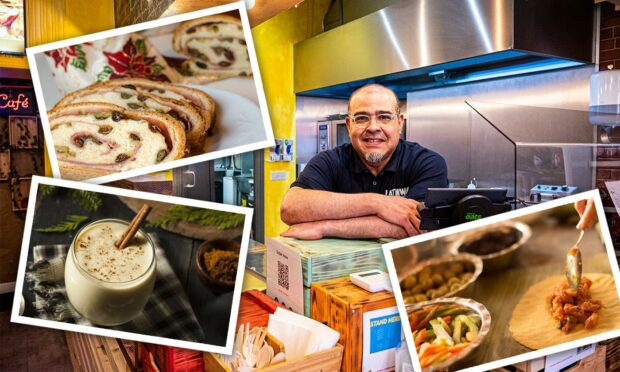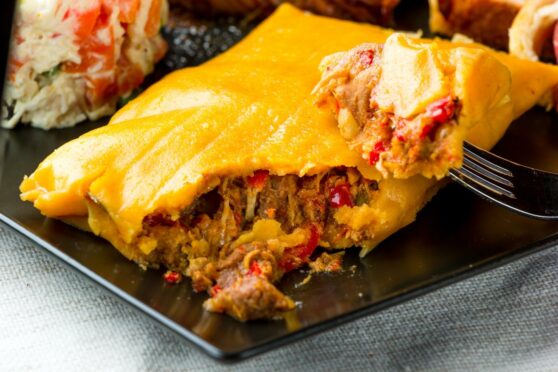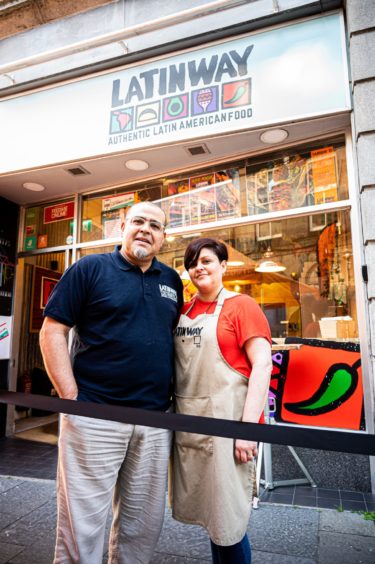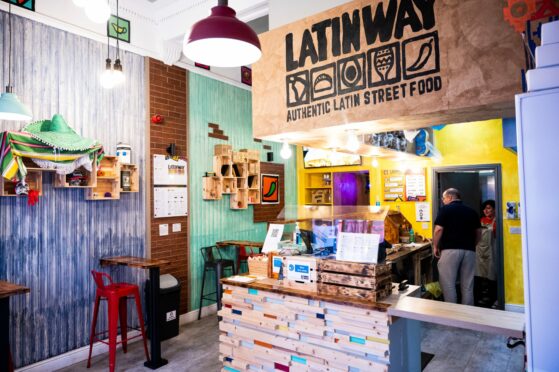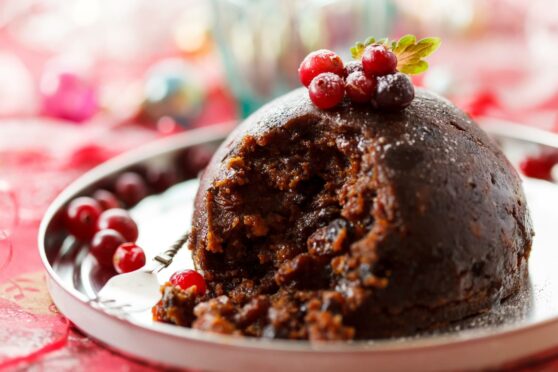Venezuela is known for its towering mountains and tropical jungles.
However its rich cuisine with influences from Spain, West Africa and Native America is also something to shout about, particularly its food staples served up during the festive period.
Segundo Castillo is keen to highlight these, along with the South American country’s main Christmas traditions.
Segundo was born and raised in Venezuela before relocating to Spain in 1998, and then Aberdeen in 2015 which is where he currently resides and operates his own street food restaurant, Latinway.
Latinway serves up a range of dishes that are the most significant and representative of street food from South America.
Despite spending considerable amounts of time in Spain and Aberdeen, the 48-year-old says Christmas in Venezuela was something “quite special.”
Festive food and drink
He recalls countless fond memories, particularly those involving enjoying hallacas – the country’s traditional dish at Christmas – with his family.
Hallacas are tamales consisting of a thin layer of corn dough stuffed with a stew of beef, pork, or chicken and other ingredients such as onions, bell peppers, raisins, capers, and olives.
They are then wrapped in plantain leaves, tied and boiled, and the typically eaten with Christmas dinner.
Segundo said: “This dish is traditionally served during the Christmas season, and it can vary depending on the region and family traditions.
“The preparation of hallacas is a reason for celebration, an occasion for reunion and cordiality, and a time for collaboration.
See recipe at the bottom of this article to make hallacas at home
“Around the table at Christmas, there’s also chicken salad and another national symbol, ham bread (a Christmas bread filled with ham and olives), accompanied by a famous drink – cream punch (our version of eggnog).
“My grandmother lived in Caracas and we stayed there during Christmas.
“All of her children (my uncles) came to the annual meeting for the preparation of the hallacas.
“Our Christmas dishes accompany us all our lives, I would dare to say that there is no Venezuelan that does not miss our tables.”
Venezuela and Scotland
Like Scotland, the festive period in Venezuela tends to kick off as Halloween comes to an end.
“Our houses must be painted and decorated for the festivities,” he adds.
“Hence why our houses at this time always have Christmas decorations like lights, garlands, trees and mangers. They change all the typography of our houses.
“We also have a musical style called gaita (a kind of bagpipe), which in general is the country’s quintessential Christmas music and is heard mostly in December.”
Segundo believes the season is adored equally by both countries.
The only main difference is, of course, the weather.
“Here there is cold and snow,” he says. “Because Venezuela is a tropical country these two characteristic elements of Europe do not usually have a presence.
“Each country has its own traditions and customs.
“For example our celebration day is December 24 and 31. The first is when we celebrate the birth of Jesus and receive his gifts and the second is the arrival of the New Year.
“Here in Scotland you celebrate December 25 instead, but also the 31.”
Inspired by UK
Other than hallacas the most emblematic dessert at festive parties is black cake, which is similar to a fruit cake.
It comprises a biscuit with fruits which have been macerated in liquor.
Segundo says: “The longer you keep the macerated fruits, the better the flavour of the cake will be.
“As you may have already realised, this is not an indigenous recipe from Venezuela. It’s true origin is the UK, which also reminds us of the multiculturalism that makes up our country.
“Obviously one of my favorites in Scotland is the Christmas pudding because it is the original version of our black cake, although I lean more towards the latter.”
Hallacas
Makes 35-40
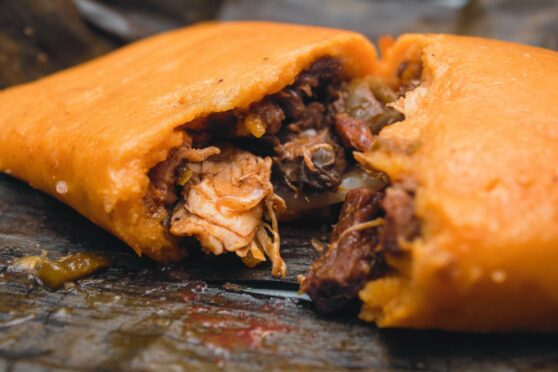
Ingredients
- 5kg banana leaves, smoked
For the achiote oil:
- 1 litre vegetable or corn oil
- 200g onoto/annatto/achiote seeds
For the guiso:
- 1.5kg beef, pork and chicken (500g each), diced
- 3 beef bouillons
- 6 white onions
- 2 leeks
- 4 green onions/scallions
- 300g garlic cloves
- 18-20 sweet peppers
- 80g capers
- 1 750ml bottle of red sweet wine
- 3 packs (1kg each) Harina P.A.N
For the toppings:
- 340g black raisins
- 600g green olives
- Pinch of salt and black pepper (if needed to season)
- Cooking twine (pabilo)
Method
How to clean and prepare banana leaves:
- Clean the banana leaves well with a damp cloth and then dry them with a dry one.
- Remove the center stem (la vena) from the leaves to make the folding process easier. When cutting the stem with scissors being careful not to break the leaf.
- Divide the leaves into three types: The main one (the biggest one) is where you have to place the dough and hallaca filling, approximately 12 x 12 inches or 30 x 30 cm squares; the second leaf (smaller than the main one) covers, encloses, and protects the hallaca while cooking, approximately 10 x 8 inches or 25 x 20 cm rectangles; the third (faja) holds in the hallacas, and all those previous leaves, together right before it is tied up with the cooking twine, approximately 10 x 4 inches or 25 x 10 cm rectangles.
How to make the achiote oil:
- Add oil to a large saucepan at medium heat. When the oil is hot, add achiote seeds. Let achiote seeds render their color for 3 to 4 minutes. Don’t let the oil boil. Remove from the stove and let cool.
- In a large container, strain through a fine-mesh strainer. Reserve the colored oil for later use.
How to make the guiso:
- Add the cut meats and enough broth to cover the meats into a large pot. Bring to a boil over medium to high heat. When boiling, reduce heat to medium to low.
- Add 250ml of achiote oil into a large skillet. When hot, add onion and cook for 3 to 4 minutes. Make sure the oil is not too hot that it is going to toast the onion.
- Add the leeks and green onion and continue cooking for 2 to 3 minutes. Add the garlic and mix to combine and cook until fragrant and soft (about 3 minutes).
- Add the sweet peppers and cook for a further 5 minutes.
- Add the sautéed vegetables to the pot with the meat and broth. Mix well and let it cook for 5 to 8 minutes. Add capers, mix and continue cooking for 5 minutes.
- In a mixing bowl, combine the sweet wine and Harina P.A.N. Mix vigorously
to prevent lumps from forming. - Add the wine mixture to the meats. You need to add the wine mixture and mix at the same time to prevent lumps from forming. Taste and add salt if needed. If the guiso is too pale, you can add more oil to add more color.
- Let the guiso cook for 5 to 8 more minutes. The guiso must be thick, not runny, so if needed, you can dissolve more Harina P.A.N in water or broth and add it to the guiso to thicken.
- Turn off the heat and let it cool.
How to make the dough (masa):
- Combine the broth reserved from the meat cooking, achiote oil, and Harina P.A.N. It should be a spreadable consistency.
How to assemble:
- Place the main banana leaf over a flat surface. Make sure the leaf vein is horizontal to make the folding process easier.
- Spread, in the middle of the leaf, around 60g of dough until it is 1/6 of an inch or 4mm thick.
- Add, in the middle of the dough, around 45g of guiso (meat filling).
- Then start adding the toppings of your choice.
- Close the hallacas: Take the top and bottom edges of the leaf and attach them upward and make sure the top and bottom edges of the dough join together. Then create a fold until it is completely sealed. Fold the other two ends towards the inside.
- Place the fold perpendicularly on the second sheet and wrap it. Fold the ends towards the inside.
- Finally, wrap around the fold with the third leaf (faja) just to hold everything together.
- Tie the hallacas with cooking twine. Cross them three times in each direction (horizontal and vertical) and close with a knot or bow, almost as you would with a gift.
How to cook:
- Fill 3/4 of a large pot with water. Add 2 to 3 tablespoons of salt. The water is supposed to taste salty, so add the salt, mix, taste, and adjust if necessary. Bring to a boil.
- When the salty water is boiling, add as many hallacas as you can fit, they
must all be completely submerged in the water and cook for 40 minutes. - Remove and drain them, preferably in the vertical position.
- Repeat the process with the other hallacas.
- Let them cool completely before refrigerating. They can be stored in a fridge for up to 4 weeks or frozen for up to six months. They must not be cooked before refrigerating or freezing.
